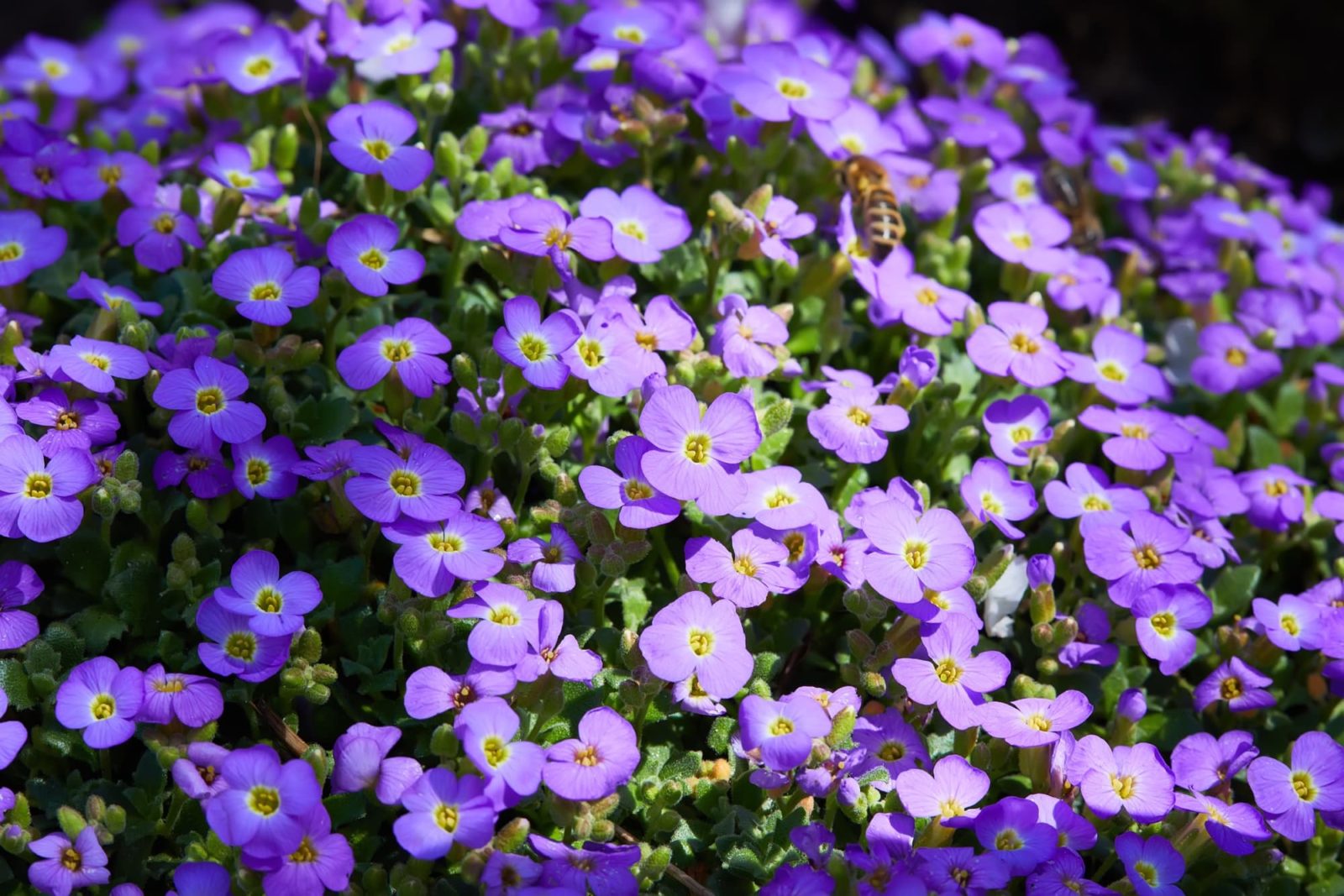PERENNIALS > AUBRIETA
Reviewed By PETER LICKORISH

Peter is a Horticulture Lecturer and self-employed Horticulturist, with a passion for diverse areas of the industry - from garden design to the science behind plant growth and propagation. He has completed the Royal Horticultural Society’s Master of Horticulture (MHort) Award and lectures on RHS courses at Bedford College.
AUBRIETA GUIDES
Aubrieta is a no-care evergreen groundcover that easily covers problem spots, tumbles out of crannies and crevices, forms a soft green mat and produces a blanket of brilliant colour during spring.
It is a first-rate choice for groundcover, rockeries, edging, planter companions, crannies and crevices and can even be grown in a hole in a wall!
Rising only up to 10cm with a spread of 3-4 times its height, this low to no-maintenance evergreen is a great ‘plant-and-forget’ option to fill bare spots and inhospitable patches with year-round foliage of a cool green shade.
Overview
| Botanical Name | Aubrieta |
| Common Name(s) | Aubrieta, False Rock Cress, Purple Rock Cress |
| Plant Type | Perennial |
| Native Area | Eastern and Southern Europe |
| Hardiness Rating | H6 |
| Foliage | Evergreen |
| Flowers | Four-petalled, open, disk-shaped, 2cm wide, typically in tones of purple and pink, but also can be white |
| When To Plant | April to June and September |
Sunlight
Preferred
Full Sun
Exposure
Exposed / Sheltered
Size
Height
0 – 0.1M
Spread
0.1 – 0.3M
Bloom Time
March to May
Soil
Preferred
Most fertile soils
Moisture
Well-drained
pH
Neutral to Alkaline
There’s also that brilliant floral colour from mid-spring through to mid-summer.
These mat-forming evergreens push up oodles of cheery little flowers in about the middle of spring.
They can bloom in such profusion that, in the flowering season, a bank of Aubrietas will transform from a mat of green to a mat of vivid colour.
The flowers are open and disk-shaped with four petals, and usually occur in tones of purple and pink, with white, cream and red hues less commonly seen, but still available.
These little blooms are a top draw for butterflies and bees.
Common Varieties
The majority of Aubrieta varieties and more so the commonly-grown ones, are about 10cm tall and their flowers are typically up to 2.5cm across.
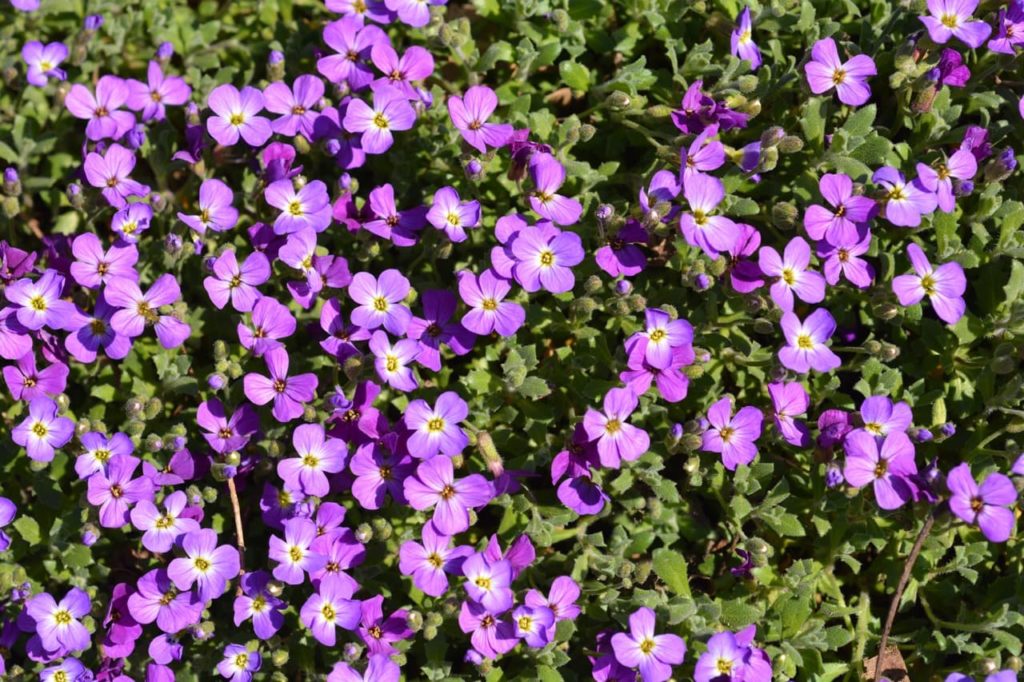
Below, I’ve listed several varieties that can be sourced without much difficulty:
- A. ‘Doctor Mules’ (AGM) – This is probably the most widely available and popular variety. Its foliage is of a brilliant green shade and the abundant flowers are of a rich purple colour.
- A. ‘Royal Blue’ – Belies its name as the flowers are actually mauve-purple.
- A. ‘Kitte’ – has rich purple to violet flowers. The ‘Kitte’ series has relatively small leaves of a light green shade. This variety has flowers that are bigger than usual and sport a yellow eye.
- A. ‘Red Cascade’ (AGM) – The ‘Cascade’ series is especially vigorous and has foliage of a bright, deep shade. ‘Red Cascade’ bears flowers of a vivid magenta-red hue.
- A. ‘Regado White’ – This cultivar has a slow but steady growth pattern and its foliage is relatively hairy and sometimes serrated. The white-white flowers are set off by yellowy-green eyes.
- A. ‘Argenteovariegata’ (AGM) – This is not as vigorous as some other cultivars. It has soft mauve to lavender flowers but is equally valued for its foliage as the relatively small leaves are variegated in green, yellow and gold.

How To Grow Aubrieta
These plants can easily be grown from seed.
Although seeds may be started indoors in trays, this is unnecessary.
It is far easier to sow this hardy perennial directly outdoors, assuming you want to grow it in the open ground.
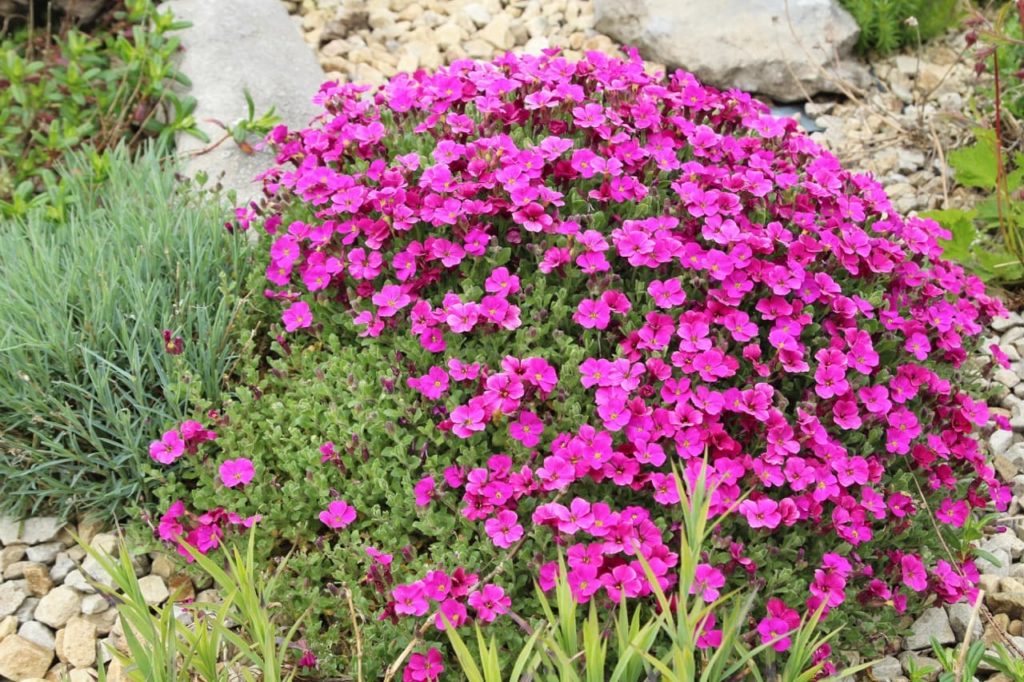
April to June is the best timeframe for sowing Aubrieta seeds outdoors.
It would be advisable to check the weather forecast so you can sow these seeds when there will be more of a dry spell.
Before sowing the seeds, till the soil with a hand hoe or rake.
Sprinkle the seeds and cover them with a mere sprinkling of soil, or nudge the seeds partway down into the soil.
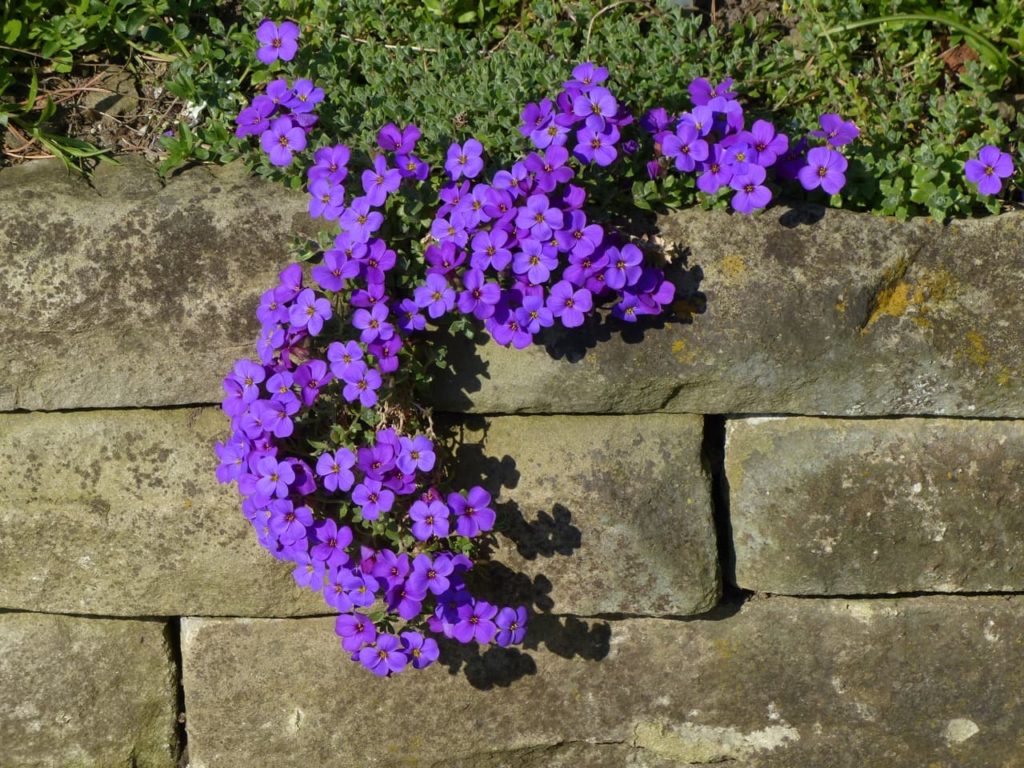
Do not cover the seeds completely, as they need light to germinate.
Water lightly with a watering can that has been fitted with a rose or a sprayer, taking care not to wash away the seeds.
Keep the soil moist until the seedlings emerge.
Another very reliable way to grow Aubrieta, particularly if you want a copy of the parent plant, is to take and plant semi-ripe cuttings in late summer to early autumn.
Hardiness
With a hardiness rating of H6, Aubrieta is fully hardy.
Even Northern European winters will not affect it, as it can withstand temperatures down to -15°C.
Light Requirements
Aubrietas prefer a south or west-facing aspect, but they can make do with other less favourable aspects.
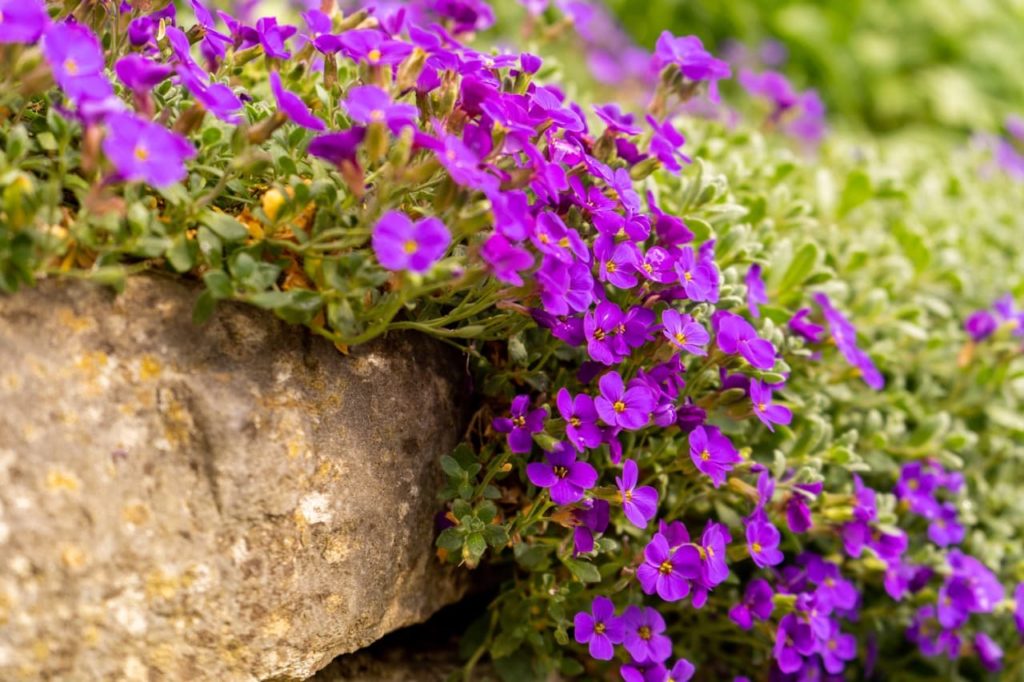
What is most essential is that they be sited in full sun, which will maximise flowering and also ensure a pleasing, compact shape.
They will struggle in partial shade and will fail to thrive in full shade.
Preferred Soil
Aubrieta grows best in lime-tending soil that is crumbly and not rich that has neutral to slightly alkaline pH.
Therefore, a mixed loam of sand, chalk and clay with only a little organic matter is perfect.
The soil should drain very well and should not stay damp or continuously moist for long periods of time.
Planting Out
Aubrietas are fantastic plants to cover bare spots where nothing else worth growing will take root.
Such spots include chalky ground, crevices and crannies, verges and slopes, paved walkways, and holes or cavities in and on walls.
This plant grows vigorously in many places and it is fairly commonly seen in the UK.

Aubrietas often form an undulating mat atop walls and sometimes make a cascading vertical blanket along walls, as these unfussy, lime-loving plants grow in clumps in cracks and crevices.
Young plants and seedlings may be transplanted into any of the inhospitable spots mentioned above.
Simply get rid of any loose stones or weeds, fill in with soil, transplant the young plant and water it in.
“I like to plant aubrieta in winter-spring hanging baskets to give one final eruption of colour before the display is swapped for summer plants,” shares Master Horticulturist Peter Lickorish.
“From these baskets, after flowering, the aubrieta can be trimmed by a third and transplanted into a small planting pocket, or even the front of a border.”
Ongoing Aubrieta Care
Aubrieta is a seriously low-care plant.
Other than the simple type of pruning outlined below, you may wish to feed established plants with a very light helping of organic fertiliser oriented to lime-loving flowering plants at the beginning of spring.

None of this is necessary, as this plant flourishes in what are usually considered poor soils.
Watering
Water young plants regularly but do not soak the soil entirely and be sure it drains well.
When watering mature plants, allow them to fully dry out before watering again.
In many regions of the UK, you will not need to water these plants at all during the wet seasons.
Established plants are drought-tolerant, but make sure that watering duties are not completely disregarded during any long stretch of dry weather.
Pruning
Aubrieta does not need any pruning, but it might be helpful to cut it back to maintain a compact size, especially if you have grown it in a wall, cranny or rockery.

Such a cutback may be done anytime from the end of the flowering season to early autumn, but not any later.
Cut back 25-50% of the plant.
Aubrietas will become unkempt and straggly after three years or so, more so if positioned in partial shade, so this type of pruning will maintain a neat look.
Common Problems
In the UK, the only pests that the vast majority of Aubrieta cultivars are susceptible to are aphids and flea beetles.
Both fall in the category of a garden nuisance rather than any serious menace and both are fairly easily controlled with biological controls and natural remedies.
They can also succumb to powdery mildew, though this strikes these plants infrequently and can be treated fairly easily.
FAQs
Will Aubrieta Grow In Shade?
Aubrieta will grow in partial shade, but it might become leggy and straggly as it searches for light and flowering will be sparse.
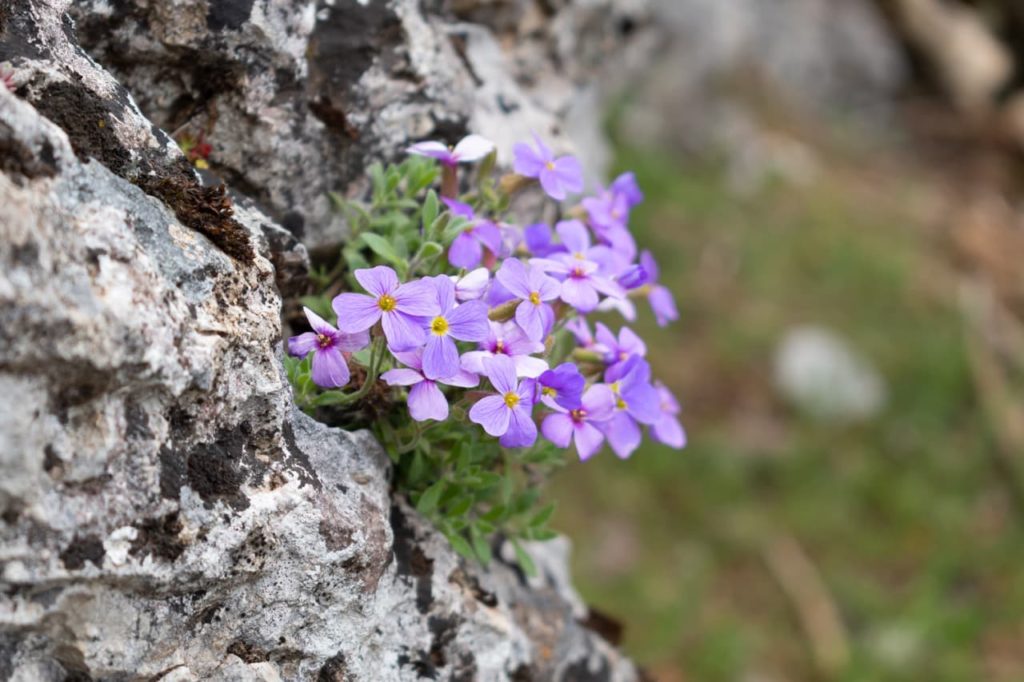
It will not grow in full shade.
Can You Split Aubrieta?
Yes.
Aubrieta is not typically propagated by division because it does not spread aggressively and there is little reason to disturb the mat-forming groundcover it gradually produces.
That said, its clumps can certainly be divided and re-planted.
“The only caution is to check that clumps have roots,” adds Peter.
“It is surprising how far the stems of this plant can spread from the original base and roots of the plant.”

